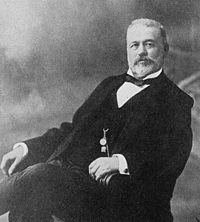
Photo from wikipedia
Particles and bubbles are important discrete elements in gas–solid fluidized beds. The interactions between them affect the evolution of agglomerates. Based on the analyses of microscopic physical processes, mathematical models… Click to show full abstract
Particles and bubbles are important discrete elements in gas–solid fluidized beds. The interactions between them affect the evolution of agglomerates. Based on the analyses of microscopic physical processes, mathematical models of particle coalescence and agglomerate breakage caused by bubble expansion were developed. Coupling with the constant-number Monte Carlo method, the evolution of particle size distribution was simulated. Modeling results matched well with cold-mode experiment results, which demonstrated that the approach is a promising way to predict agglomeration behavior in the fluidized beds. Also, the coalescence efficiency β0 and breakage efficiency βb extracted from Monte Carlo results can provide rate constants for the kernels in population balance modeling. Further investigations of the effects of process parameters show that decreasing bed temperature or increasing superficial gas velocity reduces the coalescence efficiency and increases the breakage efficiency, which are beneficial to pr...
Journal Title: Industrial & Engineering Chemistry Research
Year Published: 2017
Link to full text (if available)
Share on Social Media: Sign Up to like & get
recommendations!